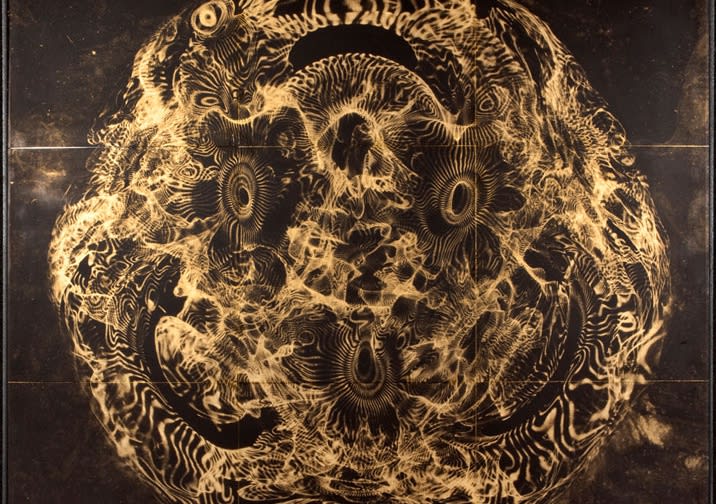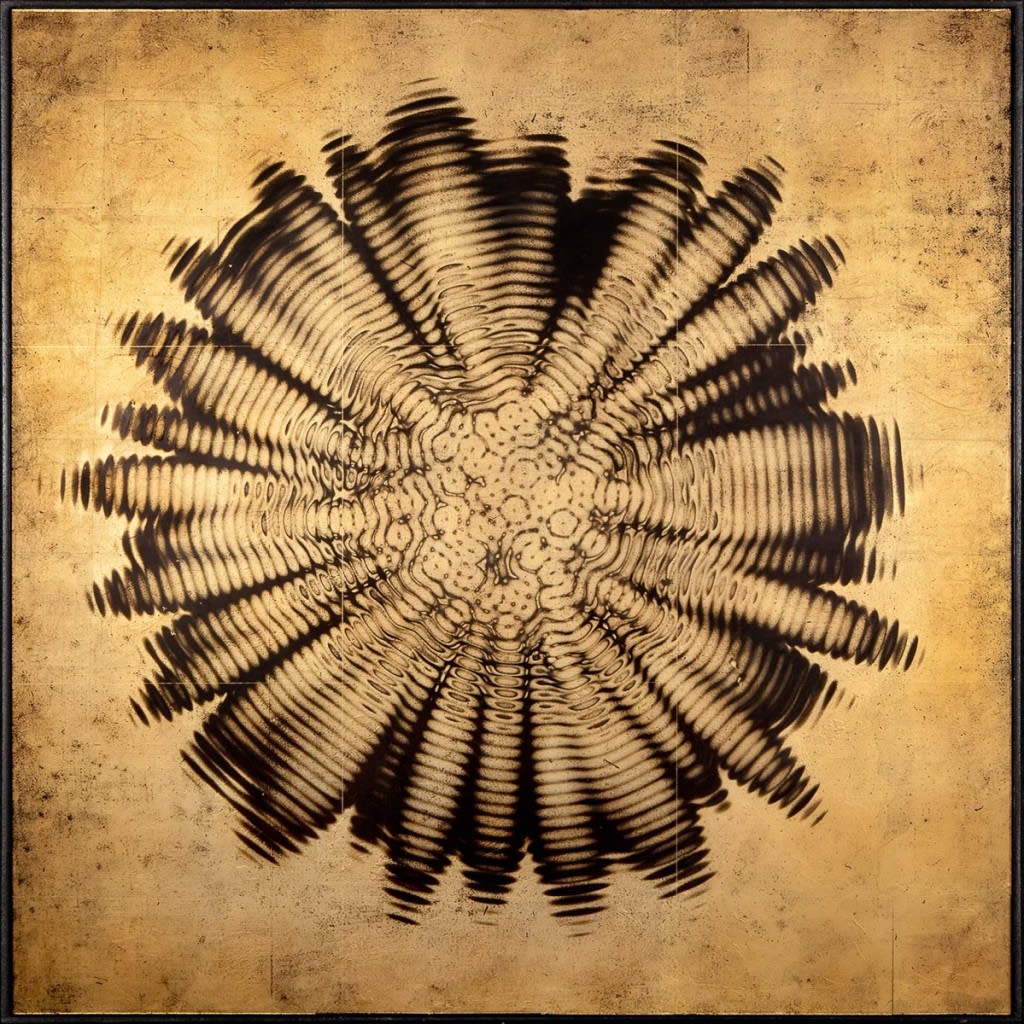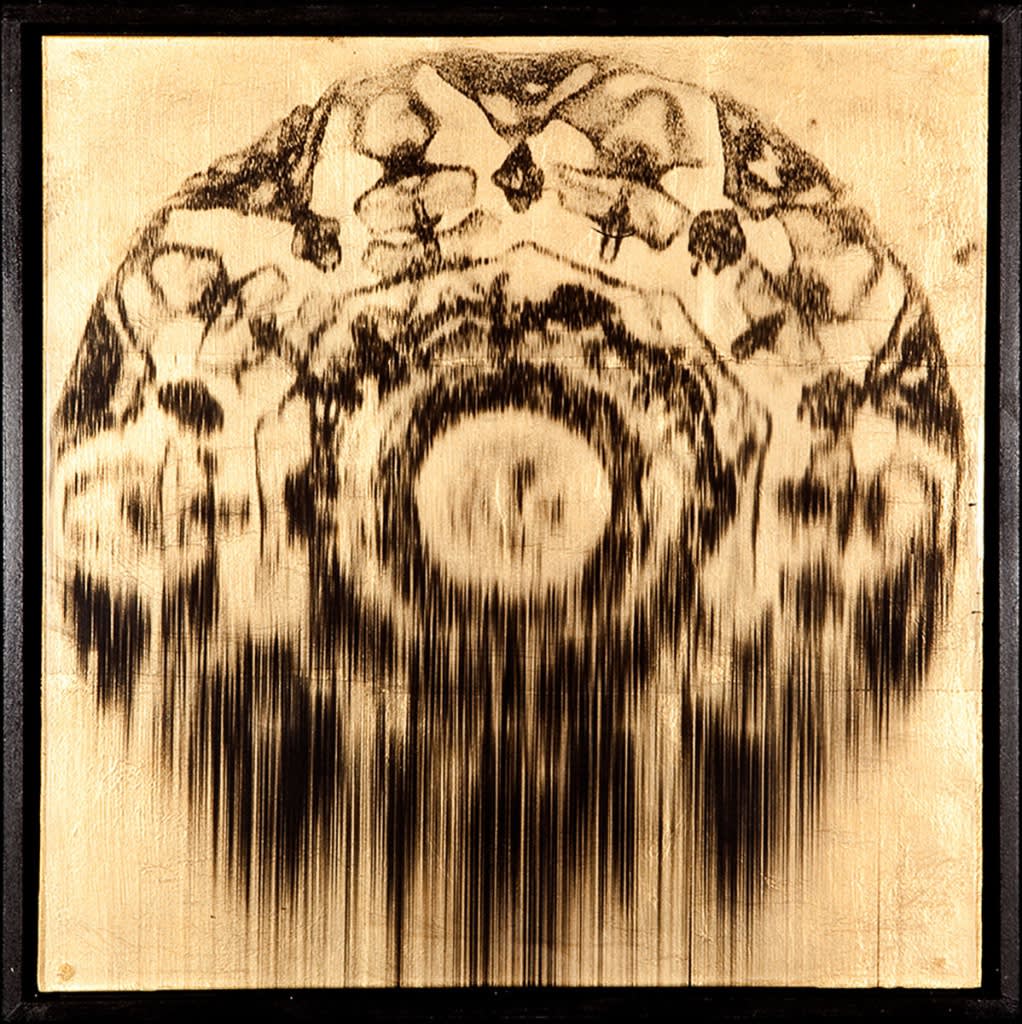
This Commentary is the third in a series about photographers I discovered in the Photo Lucida 2015 Critical Mass 50 (CM50) portfolio reviews. Each of these photographers give the viewer a vision of the world through a different set of eyes. In this series, the artists have created a visual expression to convey a message and help us see the world differently going beyond the literal mechanical capture of an image, whether on film or digitally. This article, or commentary as I refer to these, is about the creative work of a team – Louviere + Vanessa (“L+V”). (1) Jeff Louviere and Vanessa Brown live and work in New Orleans, Louisiana. The body of work to be discussed here, “Resonantia”, follows one of their “Theories” for image making which is to “strip away the parameters of time, removing the benefit of that way of contextualizing and defining what the viewer sees.” (2) In addition, the work of L+V combines a knowledge of science with the creation of art. Photography sometimes helps scientific exploration, but here science helps us see what the eye would not normally capture. It is this approach that gives the viewer the ability to see “through different eyes”.
“Resonantia” is a work made up of multiple parts: photographs, film and sound on vinyl record. The three mediums that are all part of this project are L+V’s way of presenting “sight, sound, time and space”. The word “resonant” is a Latin word that means “Echo”. “In physics, resonance is a phenomenon that occurs when a vibrating system or external force drives another system to oscillate with greater amplitude at a specific preferential frequency.” (3) L+V created 12 images, each representing a sound, a note of music. They also created a record album to accompany the visual experience. L+V express in their artist statement for this work: “This new body of work is based on the interaction of sight and sound. … This series uses photography as sculpture in that we are translating a time-based medium of sound and contrasting it with the space-based form of photography.”
With L+V’s project, you see what you are hearing, and you are hearing what you see. They describe their use of certain equipment, such as a spectrograph (4) to first create images of sounds. Three of those notes, out of the 12 created, are illustrated in this Commentary on their work. “We photographed the sounds using a handmade spectrograph. … We transformed the photograph back into a sound and created a three minute soundscape using all 12 photo-tones. We came full circle by broadcasting that song through a digital spectrometer which photographed the sound as a spectrogram revealing all 12 images.” Its a combination of photography and science and these artists have worked to differentiate what they create from the mainstream: “We believe that the dogma—everything has been done before—is false.”

L+V were not the first to marry science and photography. Electrical discharges were captured in photographic images in a process called “Kirlian” (5) photographs. Harold “Doc” Egerton, a professor at MIT is also a well known photographer recognized for his “Milk Drop” image using strobe lights and film cameras to record his images. (6) Bernice Abbott, a famous documentary and street photographer, also spent time in the 1950s at MIT capturing bouncing balls and water wave images to help illustrate scientific concepts for educational purposes, creating what’s now considered artistic images. (7) Henri Becquerel, a French physicist and later Nobel Laureate, used photographic processes to document radioactivity creating images that could (and do) pass today for modern art. (8) Waves of sound can be captured in yet another way: “Schlieren Flow Visualization”. Schlieren Flow Visualization is a process of using light and parabolic mirrors to capture the disturbance in the air from sound that can be captured on camera. (9) In yet another study, a regular DSLR camera, matched with the proper algorithms, recorded sound waves though a technique developed, again, at MIT. (10) Other artists have also turned sound into a visual creation. British artist Tim Wakefield creates images captured from the music of well-known musicians. (11) A German Audio-Visual artist, Rainer Tautenhahn, captures sound from all kinds of sources, from insects to airplanes, converts them to photographic images to create large installations. (12) Hans Jenny (1904-1972) (13) , a Swiss scientist, referenced by L+V in their Art Statement on “Resonantia”, published “Cymatics: The Study of Wave Phenomena” in 1967 as “photographic documentation of the effects of sound vibrations on fluids, powders and liquid paste”. What L+V did is to take it a step further and photograph, in their own way and technique, these sound waves.
One can get very deeply lost in all of the science behind the visualization of sound. L & V commented that in their study of photography they were also influenced by work of Edward Curtis, Eadweard Muybridge and David Lynch. “Edward Curtis was an inspiration for the process we invented with gold leaf and resin by retro engineering his orotones (14) into something new and 21st century. Muybridge is a hero along with Ladislaw Starewicz (Cameraman’s Revenge 1912) as both were using photography to explore science and David Lynch has always had a creepy place in our heart in the way he can visualize the subconscious.”

Edward S. Curtis (1868-1952) used the goldtone (aka “orotones” or “Curt-Tones”) process of printing in his well-known images of Native North American Indians. (15) This involved putting a silver emulsion on glass. After development, the glass is then backed by “gold-hued” bronzing powders. This quote was attributed to Curtis about the “Curt-Tone”, as Curtis referred to his work: “The ordinary photographic print, however good, lacks depth and transparency, or more strictly speaking, translucency. We all know how beautiful are the stones and pebbles in the limpid brook of the forest where the water absorbs the blue of the sky and the green of the foliage, yet when we take the same iridescent pebbles from the water and dry them they are dull and lifeless, so it is with the ordinary photographic print, but in the Curt-Tones all the transparency is retained and they are as full of life and sparkle as an opal.” (16) Eadweard Muybridge (1830-1904), an English photographer, performed amazing and pioneering work on human and animal motion in the 1880s by taking a series of images that stop motion to scientifically prove how movement is executed. (17) Like L+V, Muybridge’s work helped us see what the unaided human eye could not. Muybridge developed new techniques that allowed the images of motion to be captured. Science and art worked closely together. Ladislaw Starewicz was a Russian puppet animation movie-maker. One of his best known works (and one well worth watching even today) was “The Cameraman’s Revenge”, Moscow (1912). (18) In it Starewicz has created the story of romantic intrigue between some insects acting out very human frailties. There was a magic in the way Starewicz manipulated the insects creating a motion not visible to the eye, yet we saw the otherwise dead insects moving as any of us would, complemented by music in an otherwise silent movie. David Lynch, as a film-maker and photographer, was the creator of the avant-garde cult film “Eraserhead”, and the film maker for the “Elephant Man”. David Lynch’s other photographic work included distorted nudes, and images made of abandoned decaying factories in England and elsewhere which challenge the viewer and perceptions of our own reality. (19) One suspects that Lynch’s “outside of the box” approach and challenge to perceptions was a motivator for L+V to also challenge themselves to give a viewer of their images a different way of seeing.

Each of the “Resonantia” photographs have their own personality and uniqueness. While the images could have been produced in black & white, the gold tone gives the image a visually regal presence and demands more of our attention to its detail. The “D” notes is very symmetrical and most like a musical snowflake equivalent. (20) The shimmering lines give the impression of frozen ice. Its almost like a pattern lies just below the surface of water into which someone tossed a small pebble, perfectly into the center of the image to create a perfect pattern of nodal waves to obscure the pattern below. Then comes the “Spectrogram in A” note. It has the appearance of a snowflake slowly melting, dripping off the paper. One can imagine a beautifully perfect image, that was uniquely different form the “D” note, which is beginning to drain off because the sound is changing timbre, or tone quality or tone color that describes the quality of a musical note. In the “F#” note, we sense a tension. Lost is the delicate snowflake texture in sounds “A” and “D”. The “F#” sound is visually compressed and shaken. It has a darken color and tighter texture. The visual impression is as challenging on the eyes to extract a pattern as it might be on the ears. Where the other notes have some gaiety , lightness, float and drift, the “F#’ is like a hard rock, dark space or abyss. Just as we may each hear music differently, each viewer will react differently to the visual presentation of these notes.
L+V made a statement on their website that all of us, as photographers, are striving to be artists creating new and original work. With this body of work, they have proved it. L+V give the viewer in this project much more information than in most traditional photography. One can look at the images in isolation, or in conjunction with the vinyl record of sound, or the movie films of sound that is part of this. They enable, but are not forcing us, to use more than one of our senses. That is why we must look for those artists that help us see differently.
Notes:
- They have a most interesting and visually challenging website. Their background can be found at: http://www.louviereandvanessa.com/swfs/flash.htm . To fully experience this work and the images, the reader should go to the website: http://louviereandvanessa.com/recent/photographs.php to gain the whole experience of this work beyond just the visual content.
- Ibid. From the Louviere + Vanessa Website, look under the heading “Words” > “Theories”.
- https://en.wikipedia.org/wiki/Resonance
- “A spectrograph is an instrument that separates light into a frequency spectrum and records the signal using a camera. There are several kinds of machines referred to as spectrographs, depending on the precise nature of the waves. The term was first used in July, 1876 by Dr. Henry Draper when he invented the earliest version of this device…” . Wikipedia. https://en.wikipedia.org/wiki/Spectrograph , https://en.wikipedia.org/wiki/Spectrogram .
- The technique has been variously known as “electrography”, “electrophotography”, “corona discharge photography” (CDP),”bioelectrography”,”gas discharge visualization (GDV)”,[“electrophotonic imaging (EPI)”, and, in Russian literature, “Kirlianography”. https://en.wikipedia.org/wiki/Kirlian_photography Its a fascinating story actually of observation and discovery that lead to a new image creation. “The Kirlians conducted experiments in which photographic film was placed on top of a conducting plate, and another conductor was attached to a hand, a leaf or other plant material. The conductors were energized by a high-frequency high-voltage power source, producing photographic images typically showing a silhouette of the object surrounded by an aura of light.”
- http://web.mit.edu/museum/about/pr/2015/ImagesOfDiscovery-press-release.html
- https://www.brainpickings.org/2012/12/03/berenice-abbott-documenting-science/ . There is a great short video and sampling of these images done by Lumiere Gallery. http://lumieregallery.net/wp/167/berenice-abbott/ . See also the MIT article on “Images of Discovery: Communicating Science Through Photography”, currently at the MIT museum through January 10, 2017 and the article “Abbott’s Absolutes” in Nature, 1/29/1998, Vol. 391, Issue 6666, p. 445. Man Ray and his work “Electicité: Dix Rayogrammes, 1931” would have influenced Berenice Abbott as she worked for Man Ray from 1923 to 1929 in Paris.
- In fact, it is reported that 10 photographs by H. Becquerel were exhibited at the 46th annual exhibition of the Royal Photographic Society and in 2008, one from that series was hung in the San Francisco Museum of Art. From “Photography and the Art of Science. Visual Studies, Vol. 24, No.2 September 2009 by Kelley E. Wilder. http://www.earthmagazine.org/article/benchmarks-henri-becquerel-discovers-radioactivity-february-26-1896
- A short interesting video showing the concept is at: http://www.npr.org/2014/04/09/300563606/what-does-sound-look-like
- Another short but fascinating video at: http://www.diyphotography.net/move-over-schlieren-scientists-are-upping-the-sound-wave-photography-ante/ . MIT is the same institution where Egerton and Abbott captured sound. Its interesting that at the end of the brief article from MIT, the author speculated on the applications in art of this technique.
- http://www.soundwavesartfoundation.com
- See a very informative video at :http://www.odditycentral.com/pics/sonic-art-german-audio-visual-artist-makes-pictures-from-sound-waves.html .The video shows how his work has been transferred into art installed in public and institutional settings. Apparently Tautenhahn has very successfully made science an art.
- https://en.wikipedia.org/wiki/Hans_Jenny_(cymatics). An explanation of what L+V have done is seen in a video “Sand and Sound Waves: A Stunning Sci-Art Video” .The authors use sand grains on a metal plate that vibrates to different sound pitch to create visual patterns. See a video on Youtube that illustrates Jenny’s concepts: https://www.youtube.com/watch?v=W6PSA5bYTxshttp://www.slate.com/blogs/future_tense/2013/06/07/sand_and_sound_waves_how_certain_frequencies_can_vibrate_sand_into_intricate.html
- https://en.wikipedia.org/wiki/Orotone
- For a very complete explanation of Edward Curtis’ work, see the write-up at: http://www.edwardcurtis.com/collectors-guide/
- ibid, Wikipedia on “Orotone”. See also a very interesting explanation from the Indianapolis Museum of Art Conservation Department’s Claire Hovel. http://www.imamuseum.org/blog/2012/11/30/a-discussion-of-orotones/
- https://en.wikipedia.org/wiki/Eadweard_Muybridge
- The actual movie can be seen at YouTube at: https://www.youtube.com/watch?v=vIC0Sb6pLvI
- David Lynch (Born 1946) is frequently a lecturer and subject of YouTube videos, a few of which can be found here “David Lynch on Photography”: https://www.youtube.com/watch?v=2Ow6C-4pyjw
- Snowflakes have been photographed as early as 1851and the image of a snowflake is not dissimilar to the sound waves they have created. While snowflake photos were already being made in the late 1800s, they used different processes (e.g. John Dillwyn Llewelyn’s salt print photos in 1851 and Wilson Bentley’s dry plate photos around the 1900s). See Peres Osterman’s project of wet plate snowflake photos. http://petapixel.com/2016/02/16/likely-worlds-first-wet-plate-collodion-photos-snowflakes/